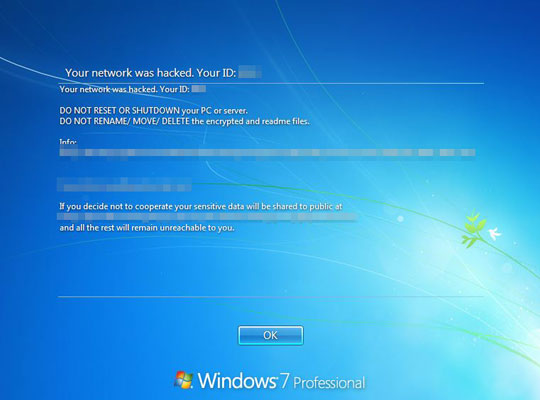Ransom.Win32.BITPAYMER.TGACAL
Trojan:Win32/Occamy.B(Microsoft); Artemis!2FC74EB5720C(McAfee);
Windows


Threat Type: Ransomware
Destructiveness: No
Encrypted:
In the wild: Yes
OVERVIEW
This Ransomware arrives on a system as a file dropped by other malware or as a file downloaded unknowingly by users when visiting malicious sites.
It drops files as ransom note.
TECHNICAL DETAILS
Arrival Details
This Ransomware arrives on a system as a file dropped by other malware or as a file downloaded unknowingly by users when visiting malicious sites.
Installation
This Ransomware drops the following files:
- %Application Data%\{Random Filename 1}
- %Application Data%\{Random Filename 2} -> random normal file can be found in system32
- %Application Data%\{Random Filename 2}:{Random Characters} -> copy of itself
- %Application Data%\{Random Characters}\{Random Filename 3} -> PUA.Win32.ProcHack.C
- %Application Data%\{Random Characters}\{Random Filename 4} -> PUA.Win32.ProcHack.C.component
- %Application Data%\{Random Characters}\WINSTA.dll -> Modified to proceed to its routine
- %User Temp%\{Random Characters}.tmp -> strings to delete all shadow copies
- %System%\msdtc.exe:0 -> Contains the original msdtc.exe content
It adds the following processes:
- %Application Data%\{Random Filename 2}:{Random Characters} {Argument to execute} {Malware Filename}
(Note: %Application Data% is the current user's Application Data folder, which is usually C:\Documents and Settings\{user name}\Application Data on Windows 2000(32-bit), XP, and Server 2003(32-bit), or C:\Users\{user name}\AppData\Roaming on Windows Vista, 7, 8, 8.1, 2008(64-bit), 2012(64-bit) and 10(64-bit).)
It adds the following mutexes to ensure that only one of its copies runs at any one time:
- MutexHelper
Other Details
This Ransomware does the following:
- It queries the following strings in the registry to gather information:
- AppEvents
- Console
- Control Panel
- Environment
- EUDC
- Identities
- Keyboard Layout
- Network
- Printers
- Software
- System
- Volatile Environment
- UserName
- UserProfile
- HomePath
- HomeDrive
- AppData
- LocalAppData
- LogonServer
- UserDomain
- It uses the following information to generate random characters for the file name it will drop:
- Computer Name
- It uses the following set of commands to delete shadow copies:
- %System%\vssadmin.exe Delete Shadows /All /Quiet
- %System%\diskshadow.exe /s %User Temp%\{Random Characters}.tmp
- It executes the following command to gain the ownership of the service MSDTC:
- %System%\takeown.exe /F %System%\msdtc.exe
- %System%\icacls.exe %System%\msdtc.exe /reset
- It uses the following argument/parameter to proceed on it malicious routine:
- 1xJ3P6g9rHq9Z9W3f0h7MP3T
- It execute the following set of commands before encrypting the file to gain its ownership:
- "%System%\takeown.exe /F {Files to be encrypted}"
- "%System%\icacls.exe {Files to be encrypted} /reset"
- It will encrypt the following set of drives in the affected system:
- Network Drives
- Fixed Drives
- Removable Drives
- It uses the following set of commands to gather the network drives connected to the system and connect to the following network drives to encrypt it's files:
- arp.exe -a
- nslookup.exe {IP address}
- It executes the following files to escalate its privileges:
- %Application Data%\{Random Characters}\{Random Characters 3} {Random Filename 4} 3884504681
- It replace the content of "%System%\msdtc.exe" with itself and the placed the original content of "%System%\msdtc.exe" to "%System%\msdtc.exe:0".
(Note: %User Temp% is the current user's Temp folder, which is usually C:\Documents and Settings\{user name}\Local Settings\Temp on Windows 2000(32-bit), XP, and Server 2003(32-bit), or C:\Users\{user name}\AppData\Local\Temp on Windows Vista, 7, 8, 8.1, 2008(64-bit), 2012(64-bit) and 10(64-bit).. %Application Data% is the current user's Application Data folder, which is usually C:\Documents and Settings\{user name}\Application Data on Windows 2000(32-bit), XP, and Server 2003(32-bit), or C:\Users\{user name}\AppData\Roaming on Windows Vista, 7, 8, 8.1, 2008(64-bit), 2012(64-bit) and 10(64-bit).)
Ransomware Routine
This Ransomware avoids encrypting files with the following strings in their file name:
- .DLL
- .exe
- schre*.bat
- svsho*.exe
- V01.lo*
- V01res*.jrs
- V01.ch*
- RacWmi*.sdf
- Web*V01.dat
- .ico
- .lnk
- .ini
- .chm
- .msi
- .sys
- .hlf
- .inf
- .lng
- .cmd
- .ttf
It avoids encrypting files with the following strings in their file path:
- RECYCLE.BIN
- System Volume Information
- %Windows%
(Note: %Windows% is the Windows folder, where it usually is C:\Windows on all Windows operating system versions.)
It appends the following extension to the file name of the encrypted files:
- .locked
It drops the following file(s) as ransom note:
- {Encrypted File Name}.readme2unlock.txt

SOLUTION
Step 1
Before doing any scans, Windows 7, Windows 8, Windows 8.1, and Windows 10 users must disable System Restore to allow full scanning of their computers.
Step 2
Note that not all files, folders, and registry keys and entries are installed on your computer during this malware's/spyware's/grayware's execution. This may be due to incomplete installation or other operating system conditions. If you do not find the same files/folders/registry information, please proceed to the next step.
Step 3
Identify and terminate files detected as Ransom.Win32.BITPAYMER.TGACAL
- Windows Task Manager may not display all running processes. In this case, please use a third-party process viewer, preferably Process Explorer, to terminate the malware/grayware/spyware file. You may download the said tool here.
- If the detected file is displayed in either Windows Task Manager or Process Explorer but you cannot delete it, restart your computer in safe mode. To do this, refer to this link for the complete steps.
- If the detected file is not displayed in either Windows Task Manager or Process Explorer, continue doing the next steps.
Step 4
Search and delete this file
- %Application Data%\{Random Filename 1}
- %Application Data%\{Random Filename 2}:{Random Characters}
- %Application Data%\{Random Characters}\{Random Filename 3}
- %Application Data%\{Random Characters}\{Random Filename 4}
- %Application Data%\{Random Characters}\WINSTA.dll
- %User Temp%\{Random Characters}.tmp
- %System%\msdtc.exe
Step 5
Scan your computer with your Trend Micro product to delete files detected as Ransom.Win32.BITPAYMER.TGACAL. If the detected files have already been cleaned, deleted, or quarantined by your Trend Micro product, no further step is required. You may opt to simply delete the quarantined files. Please check the following Trend Micro Support pages for more information:
Step 6
Restore encrypted files from backup.
Did this description help? Tell us how we did.


